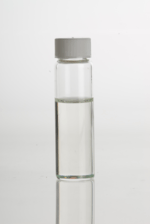Pine oil
 Pine (Pinus sylvestris) essential oil in a clear glass vial | |
| Names | |
|---|---|
| Other names
Essential oil of pine Yarmor | |
| Identifiers | |
| 8191505 | |
| 8002-09-3 | |
| ChemSpider | |
| PubChem | 2435 |
| Properties | |
| Mixture | |
| Appearance | Colorless to pale yellow liquid |
| Density | 0.95 g/cm3 at 25 °C (approximate) |
| Melting point | 5 °C (41 °F; 278 K) |
| Boiling point | 195 °C (383 °F; 468 K) |
| Insoluble | |
| log P | 1.7 |
| Vapor pressure | 4 mmHg |
| Hazards | |
| NFPA 704 | |
| Flash point | 65 °C (149 °F; 338 K) |
| Except where noted otherwise, data is given for materials in their standard state (at 25 °C (77 °F), 100 kPa) | |
| | |
| Infobox references | |
Pine oil is an essential oil obtained by the steam distillation of needles, twigs and cones from a variety of species of pine, particularly Pinus sylvestris.
It is used in aromatherapy, as a scent in bath oils, as a cleaning product, and as a lubricant in small and expensive clockwork instruments. It is naturally deodorizing, and antibacterial. It may also be used varyingly as a disinfectant, massage oil and an antiseptic. It is also used as an effective organic herbicide where its action is to modify the waxy cuticle of plants, resulting in desiccation.[2]
Pine oil is distinguished from other products from pine, such as turpentine, the low-boiling fraction from the distillation of pine sap, and rosin, the thick tar remaining after turpentine is distilled.
Chemically, pine oil consists mainly of cyclic terpene alcohols.[1] It may also contain terpene hydrocarbons, ethers, and esters. The exact composition depends on various factors, such as the variety of pine from which it is produced and the parts of the tree used.
Properties as a disinfectant
Pine oil is a phenolic disinfectant that is mildly antiseptic.[3] Pine oil disinfectants are relatively inexpensive and widely available. They are effective against Brevibacterium ammoniagenes, the fungi Candida albicans, Enterobacter aerogenes, Escherichia coli, Gram-negative enteric bacteria, household germs, Gram-negative household germs such as those causing salmonellosis, herpes simplex types 1 and 2, influenza type A, influenza virus type A/Brazil, influenza virus type A2/Japan, intestinal bacteria, Klebsiella pneumoniae, odor-causing bacteria, mold, mildew, Pseudomonas aeruginosa, Salmonella choleraesuis, Salmonella typhi, Salmonella typhosa, Serratia marcescens, Shigella sonnei, Staphylococcus aureus, Streptococcus faecalis, Streptococcus pyogenes, and Trichophyton mentagrophytes.[4]
It will kill the causative agents of typhoid, gastroenteritis (some agents), rabies, enteric fever, cholera, several forms of meningitis, whooping cough, gonorrhea and several types of dysentery.[5] It is not effective against spore related illneses, such as tetanus or anthrax, or against non-enveloped viruses such as poliovirus, rhinovirus, hepatitis B or hepatitis C.[5]
Froth flotation
Industrially, pine oil is used as collector in metal extraction from ores.[1] For example, in copper extraction pine oil is used to soak all copper sulfide ores for froth flotation. Therefore, it is important in the industry for the froth flotation process.
Safety
Pine oil has a relatively low human toxicity level, a low corrosion level and limited persistence; however, it irritates the skin and mucous membranes and has been known to cause breathing problems.[3] Large doses may cause central nervous system depression.[1]
References
- ↑ 1.0 1.1 1.2 1.3 Merck Index, 11th Edition, 7416. p. 1182
- ↑ http://www.abc.net.au/gardening/stories/s963151.htm
- ↑ 3.0 3.1 PDRhealth
- ↑ http://www.epa.gov/pesticides/reregistration/REDs/pineoil_red.pdf
- ↑ 5.0 5.1 Detailed Information On Chemical Disinfectants University of Arizona Veterinary Diagnostic Laboratory, accessed June 26, 2007.
